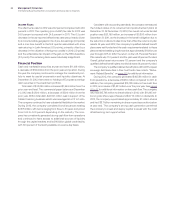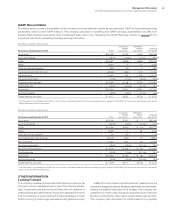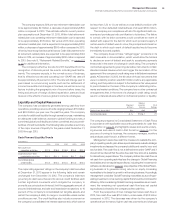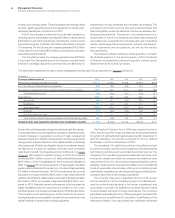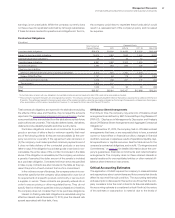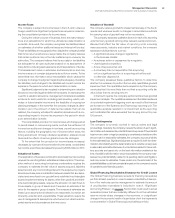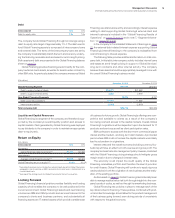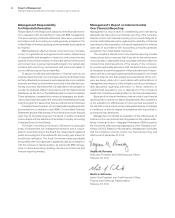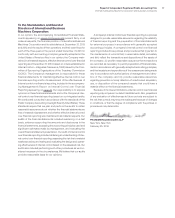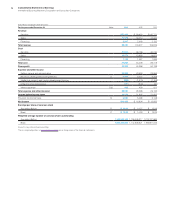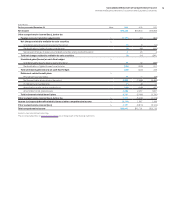IBM 2013 Annual Report Download - page 72
Download and view the complete annual report
Please find page 72 of the 2013 IBM annual report below. You can navigate through the pages in the report by either clicking on the pages listed below, or by using the keyword search tool below to find specific information within the annual report.
71
Management Discussion
International Business Machines Corporation and Subsidiary Companies
The company regularly assesses these risks and has established
policies and business practices to protect against the adverse
effects of these and other potential exposures. As a result, the com-
pany does not anticipate any material losses from these risks.
The company’s debt, in support of the Global Financing business
and the geographic breadth of the company’s operations, contains
an element of market risk from changes in interest and currency
rates. The company manages this risk, in part, through the use of a
variety of financial instruments including derivatives, as described
in note D, “Financial Instruments,” on pages 102 through 106.
To meet disclosure requirements, the company performs a sen-
sitivity analysis to determine the effects that market risk exposures
may have on the fair values of the company’s debt and other finan-
cial instruments.
The financial instruments that are included in the sensitivity
analysis are comprised of the company’s cash and cash equivalents,
marketable securities, short-term and long-term loans, commercial
financing and installment payment receivables, investments, long-
term and short-term debt and derivative financial instruments. The
company’s derivative financial instruments generally include interest
rate swaps, foreign currency swaps and forward contracts.
To perform the sensitivity analysis, the company assesses the risk
of loss in fair values from the effect of hypothetical changes in interest
rates and foreign currency exchange rates on market-sensitive instru-
ments. The market values for interest and foreign currency exchange
risk are computed based on the present value of future cash flows as
affected by the changes in rates that are attributable to the market
risk being measured. The discount rates used for the present value
computations were selected based on market interest and foreign
currency exchange rates in effect at December 31, 2013 and 2012.
The differences in this comparison are the hypothetical gains or
losses associated with each type of risk.
Information provided by the sensitivity analysis does not neces-
sarily represent the actual changes in fair value that the company
would incur under normal market conditions because, due to practi-
cal limitations, all variables other than the specific market risk factor
are held constant. In addition, the results of the model are con-
strained by the fact that certain items are specifically excluded from
the analysis, while the financial instruments relating to the financing
or hedging of those items are included by definition. Excluded items
include short-term and long-term receivables from sales-type and
direct financing leases, forecasted foreign currency cash flows and
the company’s net investment in foreign operations. As a conse-
quence, reported changes in the values of some of the financial
instruments impacting the results of the sensitivity analysis are not
matched with the offsetting changes in the values of the items that
those instruments are designed to finance or hedge.
The results of the sensitivity analysis at December 31, 2013 and
2012, are as follows:
Interest Rate Risk
At December 31, 2013, a 10 percent decrease in the levels of interest
rates with all other variables held constant would result in a decrease
in the fair market value of the company’s financial instruments of
$322 million as compared with a decrease of $192 million at Decem-
ber 31, 2012. A 10 percent increase in the levels of interest rates with
all other variables held constant would result in an increase in the
fair value of the company’s financial instruments of $300 million as
compared to an increase of $181 million at December 31, 2012.
Changes in the relative sensitivity of the fair value of the company’s
financial instrument portfolio for these theoretical changes in the
level of interest rates are primarily driven by changes in the com-
pany’s debt maturities, interest rate profile and amount.
Foreign Currency Exchange Rate Risk
At December 31, 2013, a 10 percent weaker U.S. dollar against for-
eign currencies, with all other variables held constant, would result
in an increase in the fair value of the company’s financial instruments
of $1,340 million as compared with an increase of $1,203 million at
December 31, 2012. Conversely, a 10 percent stronger U.S. dollar
against foreign currencies, with all other variables held constant,
would result in a decrease in the fair value of the company’s financial
instruments of $1,340 million compared with a decrease of $1,203
million at December 31, 2012. The change in impact from 2012 to
2013 was comprised of: assets ($59 million), debt ($2 million) and
derivatives ($76 million).
Financing Risks
See the “Description of Business” on page 33 for a discussion of
the financing risks associated with the Global Financing business
and management’s actions to mitigate such risks.
Cybersecurity
The company’s approach on cybersecurity leverages its ability
to adapt to a changing environment, as well as the depth and
breadth of its global capabilities, both in terms of its offerings to
clients and its internal approaches to cybersecurity issues. The
company has software solutions that deliver identity and access
management, data security, application security, network security
and endpoint security. IBM’s software solutions include a security
intelligence dashboard that can collect information on customer
IT security events and provide detailed information to customers
about potential threats and security posture. The company’s
services businesses offer professional solutions for security from
assessment to deployment. In addition, the company offers man-
aged and outsourced security solutions from multiple security
operations centers around the world. Finally, security is embed-
ded in a multitude of IBM offerings through secure engineering
processes and by critical functions (encryption, access control,
etc.) in servers, storage, software, services and other solutions.
From an enterprise perspective, IBM has implemented a multi-
faceted approach involving people, tools, and processes to identify
and address cybersecurity risks. The company has established
policies and procedures that provide the foundation by which IBM’s
infrastructure and data are managed, which help protect IBM and
client data. In addition, the company utilizes a combination of online
education, Web articles and other awareness initiatives to enable
its workforce to be knowledgeable about cybersecurity threats and
their responsibilities to identify and mitigate these risks. IBM per-
forms ongoing assessments regarding its technical controls and its
methods for identifying emerging risks related to cybersecurity. The
company uses a layered approach with overlapping controls to defend
against cybersecurity attacks on networks, end-user devices, data
centers and applications.



